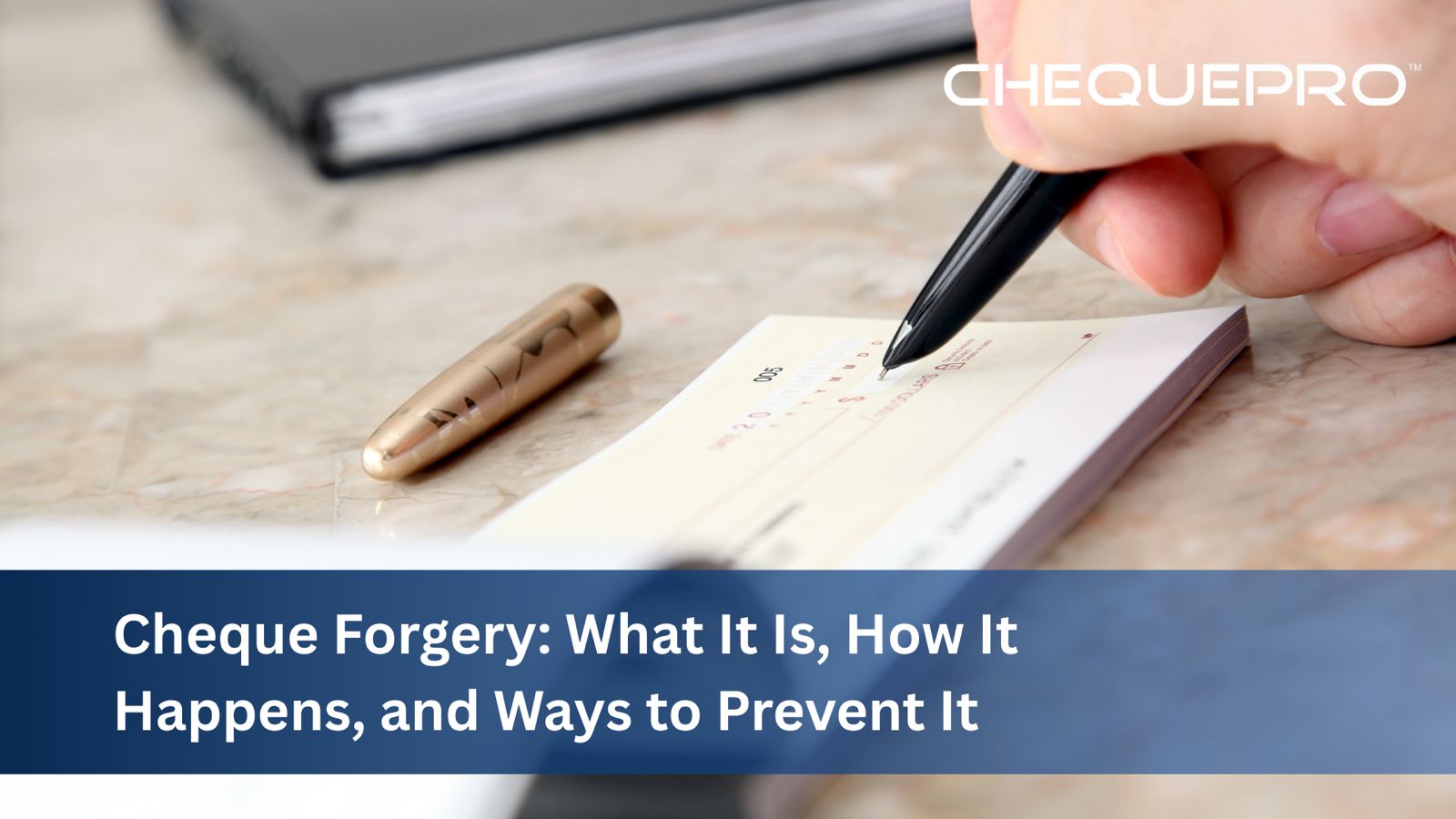Introduction
Cheque Forgery has been a big problem for decades, and even though most of our money now flows digitally, forged cheques continue to generate huge losses.
In fact, cheque fraud costs are expected to have exceeded $45 billion in 2024 alone. This crime keeps shifting shape. Every new safety measure seems to push fraudsters to invent another trick.
So it is important to know what cheque forgery is all about. In this blog, we’ll take a look at why and how it occurs, and how it can be prevented.
What is Cheque Forgery?
To put it simply, it’s when someone tampers with a cheque or creates one from scratch without permission. That might be as straightforward as forging a signature or as sophisticated as producing fake cheques on specialised paper.
In either case, the motive is the same: to mislead the bank into releasing money that they do not rightfully own.
And it is considered a serious offence. In India, cheque forgery can land someone in jail for up to two years, along with fines and compensation. For more serious cases like forging securities, the punishment can stretch to ten years or even life imprisonment.
Also Read: Fraud Detection in Banking: Strategies To Stay Ahead of Threats
The Various Ways It Happens
Over the years, a few patterns of cheque forgery have stood out. Let’s walk through the major ones:
Signature Forgery
This is the classic method of cheque forgery. A thief signs your name on a stolen cheque. Sometimes it’s a clumsy try, where they have never even seen your actual signature.
Other times, they have rehearsed carefully, and they attempt to replicate the strokes and movement of your handwriting.
There are also trace-over forgeries, where they literally trace over an original signature, which leaves darker, heavier lines that have no natural movement.
Alteration
Here, an actual cheque is used and then altered. Scammers use chemicals to wipe off the payee’s name or amount from a cheque. This trick is called cheque washing.
Technology has made it easier to do this in recent times. A scanned cheque can be digitally manipulated and then reprinted. This makes it almost impossible to distinguish from the original cheque.
Counterfeiting
With modern printers and inks, it is easy to produce a totally forged cheque. Some simply photocopy real cheques, while others put together pieces from different cheques.
Some copy the entire layout of a bank cheque, right down to the logo and watermarks.
Cheque Kiting
This is more of a matter of exploiting timing. It depends on bouncing funds from one account to another using cheques that technically do not have money.
By the time the bank realises the first cheque is invalid, the fraudster would have already drawn out or cashed out another cheque. It’s a processing delay-based cycle.
Modern Tricks
Technology has opened doors to new scams. Some scammers even use pens with disappearing ink, so that they can rewrite details after the cheque is signed.
Others misuse remote deposit systems, which involve depositing a cheque by scanning and then attempting to cash the original elsewhere. In 2023 alone, this cost banks approximately $400 million.
How Big Is the Problem?
The figures are seriously alarming. Approximately 65 per cent of the banks reported recent attempts at cheque forgery. In the United States, almost two million stolen cheques were discovered for sale online in 2024.
Identity theft drives much of this, and synthetic identity fraud, combining real and false information, totalled $6 billion in losses globally. If the situation doesn’t change, cheque forgery may cost up to $30 billion worldwide in the near future.
What Banks Have Done So Far
In India, the RBI introduced the CTS 2010 standards, which provided cheques with several layers of security.
This includes watermarks that reflect under light, UV ink that becomes visible under ultraviolet light, and paper that responds poorly to chemical tampering. On top of these, some banks introduce fluorescent bands and reverse-printed account numbers.
These measures do make counterfeiting more difficult for fraudsters, but the fact is that no design is inaccessible. Prevention has therefore turned to cleverer systems.
Prevention in Practice
Positive Pay System
From 2021, the RBI has been mandating the pre-submission of cheque details for values higher than a specific amount by account holders. The bank cross-verifies when presenting the cheque.
From 2025, it became compulsory for cheque values higher than five lakh rupees. If something doesn’t align, the cheque gets flagged outright.
Artificial Intelligence
AI is now a giant part. Systems learn in the normal manner how an account behaves, and if something about a transaction seems off, they will flag it.
Image analysis software scans for whether a signature appears genuine or the paper itself is consistent with what the bank prints out. Some of these systems boast better than 95 per cent accuracy.
Extra Monitoring
Banks are now even checking dark web marketplaces to catch stolen cheques before they’re cashed.
They’ve also started swapping fraud information with other banks. This enables them to move quickly against repeat perpetrators and take action.
Everyday Safety Measures
- Always fill in cheques with permanent dark ink.
- Don’t leave spaces that can be filled in.
- Keep your cheque books safe and report missing leaves immediately.
- If you want to make a correction on a cheque, fill in a new one instead of overwriting on the same cheque.
- And for businesses, measures such as dual authorisation for high-value cheques and frequent reconciliation of accounts add strong security.
What’s Coming Next
The RBI is going to introduce continuous clearing in October 2025. This will reduce cheque settlement periods to a matter of a few hours. This will also allow banks to detect fraud sooner.
Banks all over the world are testing blockchain authentication and even more advanced biometric verification.
The main goal is to make it so tough and so quick to authenticate a cheque that criminals don’t have the time or room to take advantage of the system.
Also Read: Understanding the Technology Behind E-Signatures
Conclusion
Cheque forgery can seem like an old-fashioned con, but it’s very much alive and evolving. Criminals are using modern tricks these days, and each time security is increased, they find a new way around.
But banks, regulators, and consumers are not helpless, as banks are developing new ways to tackle this problem regularly, so there is a way to keep this crime under control.
Stopping cheque forgery isn’t something banks or regulators can do alone. People and businesses need to stay alert, too, because only then way the system really hold up. That combined effort is what will keep the financial system secure.





